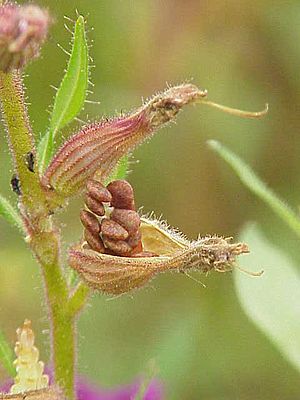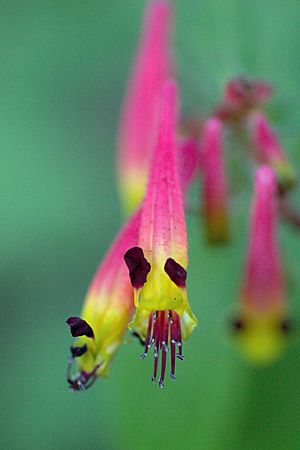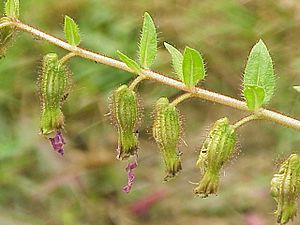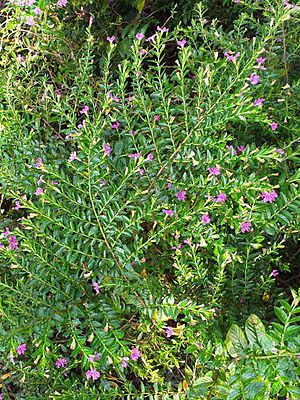Cuphea facts for kids
Quick facts for kids Cuphea |
|
|---|---|
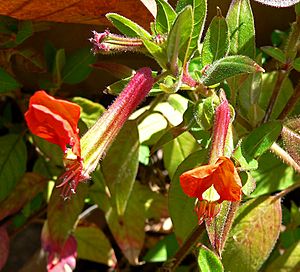 |
|
| Cuphea nudicostata | |
| Scientific classification |
|
| Kingdom: | Plantae |
| Clade: | Tracheophytes |
| Clade: | Angiosperms |
| Clade: | Eudicots |
| Clade: | Rosids |
| Order: | Myrtales |
| Family: | Lythraceae |
| Subfamily: | Lythroideae |
| Genus: | Cuphea P.Browne |
| Species | |
|
Some 260, see text |
|
| Synonyms | |
|
Cuphaea Moench, orth. var. |
|
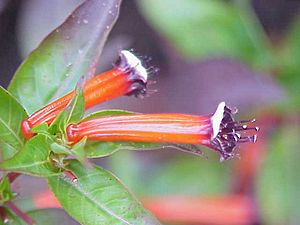
Cuphea (say "KYOO-fee-uh") is a group of about 260 different kinds of flowering plants. You can find them in warm parts of the Americas, from temperate (mild) areas to tropical (hot and humid) regions.
These plants can be small, soft plants called herbs, or they can be like small, woody shrubs that grow up to 2 meters (about 6.5 feet) tall. Some Cuphea plants live for only one year (these are called annuals). Others live for many years (these are called perennials). People often call them "cupheas" or, for some types, "cigar plants." The name Cuphea comes from a Greek word, kyphos, which means "bent" or "humped."
Contents
How Cuphea Plants Are Used
Many Cuphea species are popular ornamental plants. This means people grow them because they look pretty in gardens. They are also good honey plants, which means they attract bees and other insects that make honey. For example, C. ignea 'David Verity' and C. micropetalia are great for attracting hummingbirds.
Cuphea Oil: A Green Choice
Some Cuphea plants are used to make special oils called cuphea oil. These oils are full of healthy fats called medium-chain triglycerides. Cuphea oil is very similar to coconut oil and palm oil. However, coconut and palm trees grow only in tropical places. Growing too many of these trees has caused a lot of habitat destruction in tropical forests.
Cuphea plants can grow in milder climates. This means they can be a good source of income for farmers in places that are not tropical. By growing Cuphea, we can get more of these useful oils. This helps meet the demand for things like biodiesel and other products, without needing to cut down as many trees in tropical countries. Scientists have even created special Cuphea plants by mixing two types, C. lanceolata and Clammy Cuphea (C. viscosissima), to help with this.
Helping Farm Crops Grow Better
Cuphea plants can also help improve farm crops in North America. Farmers often use a method called crop rotation. This means they grow different crops in the same field each year. Crop rotation helps make the soil healthier, controls pests that only attack certain plants, and reduces the need for too much fertilizer and pesticides.
Scientists from the Agricultural Research Service of the USDA studied what happens when Cuphea is part of a crop rotation with corn and wheat. They found that adding Cuphea had good effects. The next harvest of corn and wheat produced more crops, and the crops had more protein. This research shows how Cuphea can help farmers grow more profitable crops like wheat and corn.
Special Oils and Potential Uses
The seeds of some Cuphea species have oils that are very rich in one special type of fat, called a fatty acid. For example, C. painteri oil is about three-quarters caprylic acid. C. carthagenensis oil is mostly lauric acid, about 80% of it. The oil from C. koehneana might be the best natural source of a single fatty acid, with 95% of it being capric acid.
Even though Cuphea is not commonly used as medicine right now, scientists are studying its oils. They think these oils might be able to fight algae, fungi, or even act like antibiotics against some germs. There is also a chance that the plant could help people who need to eat more by making them feel hungrier.
Selected Species
Here are some of the many different types of Cuphea plants:
- Cuphea aspera Chapman
- Cuphea carthagenensis (Jacq.) J.F.MacBr.
- Cuphea cyanea DC.
- Cuphea decandra W.T.Aiton
- Cuphea elegans
- Cuphea epilobiifolia
- Cuphea hookeriana Walp.
- Cuphea hyssopifolia Kunth – false heather, Mexican heather
- Cuphea ignea A.DC.
- Cuphea ingrata Cham. et Schltdl.
- Cuphea jorullensis Kunth
- Cuphea koehneana Rose
- Cuphea laminuligera Koehne
- Cuphea lanceolata W.T.Aiton
- Cuphea linarioides Cham. et Schltdl.
- Cuphea llavea Lex. – bat-faced cuphea
- Cuphea lutea Rose
- Cuphea lutescens Hoehne
- Cuphea melvilla Lindl.
- Cuphea mesostemon Koehne
- Cuphea micropetala Kunth
- Cuphea nudicostata
- Cuphea oreophila
- Cuphea painteri Rose
- Cuphea parsonsia (L.) R.Br. ex Steud. – island wax weed
- Cuphea procumbens Ortega
- Cuphea salvadorensis Standl.
- Cuphea speciosa Mart.
- Cuphea strigulosa
- Cuphea viscosissima Jacq. – clammy cuphea, blue waxweed, tarweed
- Cuphea wrightii A.Gray
See also
 In Spanish: Cuphea para niños
In Spanish: Cuphea para niños


